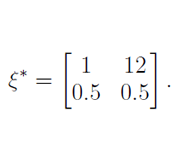Dπ-optimal designs for heteroscedastic nonlinear models: A robustness study
Main Article Content
Keywords
Optimal designs, information matrix, equivalence theorem, prior distribution, heteroscedastic models
Abstract
Optimal designs are used to determine the best conditions where an experiment should be performed to obtain certain statistical properties. In heteroscedastic nonlinear models where variance is a function of the mean, the optimality criterion depends on the choice of a local value for the model parameters. One way to avoid this dependency is to consider an a priori distribution for the vector of model parameters and incorporate it into the optimality criterion to be optimized. This paper considers D-optimal designs in heteroscedastic nonlinear models when a prior distribution associated with the model parameters is incorporated. The equivalence theorem is extended by considering the effect of the prior distribution. A methodology for the construction of discrete and continuous prior distributions is proposed. It is shown, with an example, how optimal designs can be found from the constructed distributions with a greater number of experimental points than those obtained with a local value. The efficiency of the designs found is very competitive compared to the optimal local designs. Additionally, prior distributions of a scale family are considered, and it is shown that the designs found are robust to the choice of the prior distribution chosen from this family.
Downloads
References
[1] H. Dette and W. Müller, “Optimal designs for regression models with a constant coefficient of variation,” Journal of Statistical Theory and Practice, vol. 7, no. 4, pp. 658–673, 2013. https://doi.org/10.1080/15598608.2013.781833
[2] H. Dette and W. K. Wong, “Optimal Designs When the Variance Is A Function of the Mean,” International Biometric Society, vol. 55, pp.925–929, 1999. https://doi.org/10.1111/j.0006-341X.1999.00925
[3] D. Downing, V. V. Fedorov, and S. Leonov, “Extracting Information from the Variance Function: Optimal Design,” mODa6 Physica, Heidelberg, pp.45–52, 2001. https://doi.org/10.1007/978-3-642-57576-1_6
[4] J. Gaviria and V. López-Ríos, “Locally d-optimal designs with heteroscedasticity: A comparison between two methodologies,” Revista Colombiana de Estadística, vol. 37, no. 1, pp. 93–108, 2014.
[5] J. Burridge and P. Sebastiani, “D-optimal designs for generalised linear models with variance proportional to the square of the mean,” Biometrika, vol. 81, no. 2, pp. 295–304, 1994.
[6] A. C. Atkinson and R. D. Cook, “D-optimum designs for heteroscedastic linear models,” Journal of the American Statistical Association, vol. 90, pp. 204–212, 1995.
[7] H. Dette and W. K. Wong, “Optimal bayesian designs for models with partially specified heteroscedastic structure,” Annals of Statistics, vol. 24, pp. 2108–2127, 1996.
[8] Z. Fang and D. P. Wiens, “Integer-valued, minimax robust designs for estimation and extrapolation in heteroscedastic, approximately linear models,” Journal of the American Statistical Association, vol. 95, pp. 807–818, 2000.
[9] B. P. M. Duarte and W. K. Wong, “Finding Bayesian Optimal Designs for Nonlinear Models: A Semidefinite Programming-Based Approach,” International Statistical Review, vol. 83, no. 2, pp. 239–262, 2015. https://doi.org/10.1111/insr.12073
[10] H. T. Abebe, F. E. S. Tan, G. J. P. V. Breukelen, J. Serroyen, and M. P. F. Berger, “On the Choice of a Prior for Bayesian D-Optimal Designs for the Logistic Regression Model with a Single Predictor,” Communications
in Statistics - Simulation and Computation, vol. 43, no. 7, pp. 1811–1824, 2014. https://doi.org/10.1080/03610918.2012.745556
[11] I. Burghaus and H. Dette, “Optimal designs for nonlinear regression models with respect to non-informative priors,” Journal of Statistical Planning and Inference, vol. 154, pp. 12–25, 2014. https://doi.org/10.1016/j.jspi.2014.05.009
[12] M. Buzoianu and J. B. Kadane, “Optimal Bayesian Design for Patient Selection in a Clinical Study,” Biometrics, vol. 65, no. 3, pp. 12–25, 2009. https://doi.org/10.1111/j.1541-0420.2008.01156.x
[13] D. Braess and H. Dette, “On the number of support points of maximin and bayesian optimal designs,” Ann. Statist., vol. 35, no. 2, pp. 772–792, 04 2007. https://doi.org/10.1214/009053606000001307
[14] D. C. Woods, A. M. Overstall, M. Adamou, and T. W. Waite, “Bayesian design of experiments for generalized linear models and dimensional analysis with industrial and scientific application,” Quality Engineering, vol. 29, no. 1, pp. 91–103, 2017. https://doi.org/10.1080/08982112.2016.1246045
[15] M. Goudarzi, “Bayesian optimal design for nonnegative binomial regression model with uniform prior,” J Adv Pharm Edu Res, vol. 9, no. S2, pp. 52–55, 2019.
[16] O. A. Bodunwa, O. K. y Fasoranbaku, “D-optimal design in linear model with different heteroscedasticity structures,” International Journal of Statistics and Probability, vol. 9, no. 2, pp. 7–12, 2020. https://doi.org/ijspv9n2p7
[17] V. I. Mosquera-Benitez, J. C. y López-Ríos, “Efecto de distribuciones a priori en los diseños d-óptimos bayesianos para un modelo no lineal correlacionado,” Ciencia en Desarrollo, vol. 10, no. 2, pp. 165–178, 2019. https://doi.org/10.19053/01217488.v10.n2.2019.9504
[18] W. K. Duarte, B. P. M. y Wong, “Finding bayesian optimal designs for nonlinear models: A semidefinite programming-based approach,” Int Stat Rev., vol. 83, no. 2, pp. 239–262, 2015. https://doi.org/10.1111/insr.12073
[19] H. Abebe, F. Tan, G. Breukelen, and M. Berger, “Jmasm45: A computer program for bayesian d-optimal binary repeated measurements designs (matlab),” Journal of Modern Applied Statistical Methods, vol. 16, no. 1, pp. 689–721, 05 2017. https://doi.org/10.22237/jmasm/1493599020
[20] C. Ritz and J. Streibig, Nonlinear Regression with R. Springer, New York, 2008.
[21] V. I. López-Ríos and R. Ramos, “Una introducción a los diseños óptimos,” Revista Colombiana de Estadística, vol. 30, no. 1, pp. 37–51, 2007.
[22] J. Kiefer and J. Wolfowitz, “The equivalence of two extremum problems,” Canadian Journal of Mathematics, vol. 12, no. 1, pp. 363–366, 1960.
[23] V. López-Ríos, Diseños óptimos para discriminación y estimación en modelos no lineales. Guanajuato, México: Centro de Investigación en Matemáticas A.C., 2008.
[24] C. Patiño, “Diseños D_-óptimos para modelos no lineales heteroscedásticos con inforación a priori,” Master’s thesis, Universidad Nacional de Colombia, 2017.
[25] R Core Team, R: A Language and Environment for Statistical Computing, R Foundation for Statistical Computing, Vienna, Austria, 2017. http://www.R-project.org/
[26] S. Rana, H. Midi, and A. Imon, “Robust wild bootstrap for stabilizing the variance of parameter estimates in heteroscedastic regression models in the presenceof outliers,” Mathematical Problems in Engineering, vol. 95, 2012.

